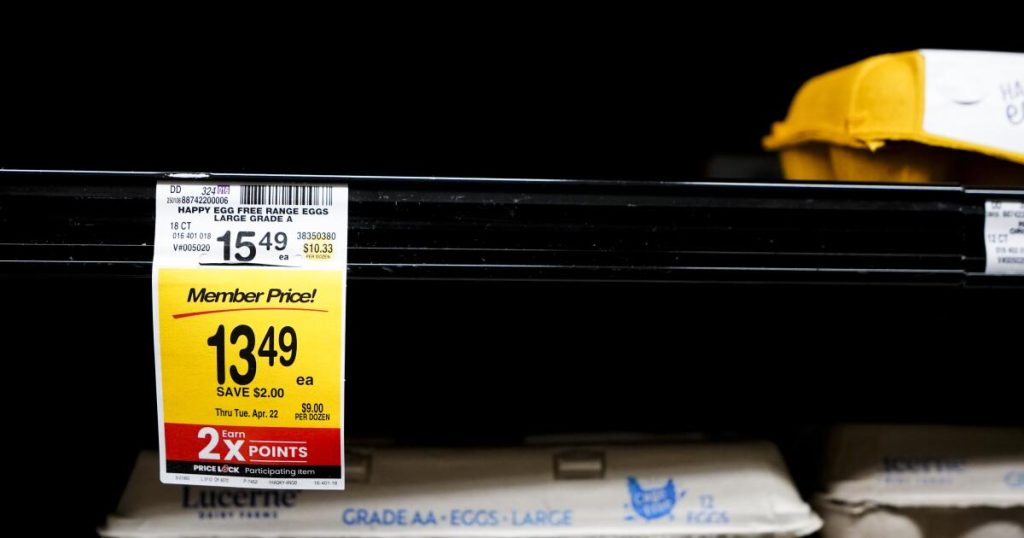Inflation in the United States surged in January, driven by rising costs for groceries, gasoline, and used cars, presenting a challenge for both households and businesses grappling with higher expenses. According to a report released by the Labor Department, the Consumer Price Index (CPI) rose 3% in January compared to the same period a year ago, up from 2.9% in December. This marks a steady increase from September’s 2.4%, which was the lowest level in 3.5 years. The persistent rise in inflation has remained above the Federal Reserve’s 2% target for the past six months, following a decline over the previous year and a half. This trend has significant implications for both economic policy and political discourse.
The elevated inflation rate has emerged as a critical issue, particularly for former President Biden, who faced criticism for rising costs during his administration. President Trump, during his campaign, vowed to reduce prices, though economists have expressed concerns that his proposed tariffs could exacerbate inflation in the short term. The unexpected increase in inflation has tempered some of the optimism among businesses that followed Trump’s election, as his pledges to cut taxes and reduce regulations had initially buoyed market confidence. The stock market reacted swiftly, with Dow futures plunging 400 points, and bond yields rising in anticipation of higher inflation and interest rates.
Excluding the volatile food and energy categories, core consumer prices rose 3.3% in January compared to the previous year, up from 3.2% in December. Core inflation is closely monitored by economists as it often provides insights into the future trajectory of price increases. On a monthly basis, inflation jumped 0.5% in January, the largest increase since August 2023, while core prices climbed 0.4%, the most since March 2024. Grocery prices alone rose 0.5% in January, fueled by a 15.2% surge in egg prices, the largest monthly increase since June 2015. Over the past year, egg prices have soared 53%, largely due to an avian flu outbreak that has led to the culling of millions of birds. As a result, some stores have imposed limits on egg purchases, and restaurants have introduced surcharges for egg-based dishes.
Other notable price increases include a 2% rise in car insurance costs from December to January and a 1.4% increase in hotel prices. Gasoline prices also rose 1.8% last month. Inflation often sees a seasonal uptick in January as companies typically raise prices at the beginning of the year, though government adjustments are intended to account for this pattern. Later on Wednesday, Federal Reserve Chair Jerome Powell testified before the House Financial Services Committee, where he was likely grilled on inflation and the Fed’s response to it. The central bank has taken decisive action in recent years, raising its benchmark interest rate to a two-decade high of 5.3% in 2022 and 2023 to combat inflation. However, with inflation down significantly from its peak of 9.1% in June 2022, the Fed cut its rate to around 4.3% in its final three meetings of last year.
Despite these efforts, the recent uptick in inflation has cast doubt on the likelihood of further interest rate cuts in the near term. Powell emphasized that the Fed is in no rush to implement additional rate reductions, stating, “We do not need to be in a hurry.” Meanwhile, Trump called for lower interest rates on social media, suggesting that such a move would align with his plans to impose new tariffs. However, the increase in consumer prices makes it less likely that the Fed will cut rates anytime soon. Fed officials remain cautiously optimistic that inflation will decline over time, but they are seeking further evidence of a downward trend before considering any additional rate cuts. The central bank’s benchmark rate has a ripple effect on other borrowing costs, including mortgages, auto loans, and credit cards.
The recent surge in inflation has also brought attention to the potential impact of Trump’s tariff policy, which could push prices higher in the coming months. Trump recently imposed 25% tariffs on steel and aluminum imports and has pledged to introduce more tariffs, a move that economists warn could temporarily increase costs for consumers. According to a forecast by Goldman Sachs, yearly core inflation could fall to 2.3% by the end of the year without additional tariffs, but the implementation of such measures could raise inflation to 2.8%. Powell acknowledged the potential for tariffs to lift inflation and limit the Fed’s ability to cut rates, though he noted that the extent of the impact would depend on the specifics of the tariffs and how long they remain in place. “In some cases, it doesn’t reach the consumer much, and in some cases, it does,” Powell remarked. “And it really does depend on facts that we haven’t seen yet.”
In summary, the acceleration of inflation in January has posed a significant challenge for the Federal Reserve, which is now more likely to maintain its current interest rate stance. The rise in prices has far-reaching implications, from the strain on household budgets to the potential disruption of business confidence. As the Fed navigates this complex economic landscape, the interplay between inflation, interest rates, and trade policy will remain a critical focus for policymakers and economists alike. For now, consumers and businesses will have to contend with higher costs, while hoping for signs that inflation may stabilize in the months ahead.
